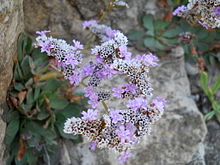
Limonium is a genus of 120 flowering plant species. Members are also known as sea-lavender, statice, caspia or marsh-rosemary. Despite their common names, species are not related to the lavenders or to rosemary. They are instead in Plumbaginaceae, the plumbago or leadwort family. The generic name is from the Latin līmōnion, used by Pliny for a wild plant and is ultimately derived from the Ancient Greek leimon.

The Tuscan Archipelago is a chain of islands between the Ligurian Sea and Tyrrhenian Sea, west of Tuscany, Italy.

Reynoutria multiflora is a species of flowering plant in the buckwheat family Polygonaceae native to central and southern China. It is known by the English common names tuber fleeceflower and Chinese (climbing) knotweed. It is known as he shou wu in China and East Asia. Another name for the species is fo-ti, which is a misnomer. The name he shou wu means 'the black-haired Mr. He'.

The wildlife of Morocco is composed of its flora and fauna. The country has a wide range of terrains and climate types and a correspondingly large diversity of plants and animals. The coastal areas have a Mediterranean climate and vegetation while inland the Atlas Mountains are forested. Further south, the borders of the Sahara Desert are increasingly arid. Large mammals are not particularly abundant in Morocco, but rodents, bats and other small mammals are more plentiful. Four hundred and ninety species of birds have been recorded here.

Helicia is a genus of 110 species of trees and shrubs, constituting part of the plant family Proteaceae. They grow naturally in rainforests throughout tropical South and Southeast Asia, including India, Sri Lanka, Indochina, Peninsular Malaysia to New Guinea and as far south as New South Wales.

Limonium strictissimum is a species of plant in the family Plumbaginaceae. It is found in France and Italy. Its natural habitat is Mediterranean-type shrubby vegetation. It is threatened by habitat loss.
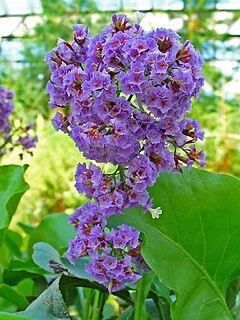
Limonium arboreum is a species of sea lavender known by the common name tree limonium and siempreviva. It is endemic to the Canary Islands, where it is a plant of coastal habitat.
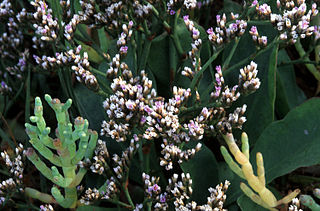
Limonium californicum is a species of sea lavender in the family Plumbaginaceae. It is known by the common names western marsh rosemary and California sea lavender.
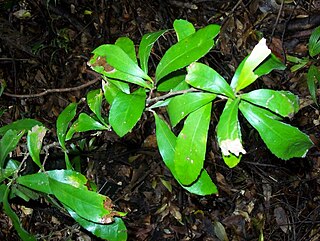
Helicia glabriflora is a species of rainforest shrubs or small trees occurring in eastern Australia. Common names include smooth or pale helicia, pale, leather or brown oak. They grow naturally in a variety of different rainforest types from the Illawarra, New South Wales to the Townsville area, Queensland. Of all the global diversity of approximately one hundred Helicia species, this one species naturally grows the furthest south, in the Minnamurra Rainforest and the Robertson area, Illawarra, New South Wales, there observed more on the relatively fertile basalt and alluvial soils.
Salvatore Brullo is professor at University of Catania since 1980 teaching Systematic Botany, he obtained a degree in natural science on July 1970. For six years he was Director of the Department of Botany, at the University of Catania.
Helicia blakei, also named Blake's silky oak, is a species of rainforest tree, of northeastern Queensland, Australia, from the flowering plant family Proteaceae.
Palaquium multiflorum is a tree in the family Sapotaceae. The specific epithet multiflorum means "many flowers".

Limonium narbonense is a species of sea lavender belonging to the family Plumbaginaceae.
Limonium jovibarba is a species of flowering plants of the family Plumbaginaceae. The species is endemic to Cape Verde. It is listed as critically endangered by the IUCN. The species was named by Carl Ernst Otto Kunze in 1891. Its local name is carqueja, a name that may also refer to the related species Limonium brunneri and Limonium braunii.
Limonium brunneri is a species of flowering plants of the family Plumbaginaceae. The species is endemic to Cape Verde. It is listed as critically endangered by the IUCN. The species was named by Carl Ernst Otto Kunze in 1891. Its local name is carqueja, a name that may also refer to the related species Limonium braunii and Limonium jovibarba.
Limonium braunii is a species of flowering plants of the family Plumbaginaceae. The species is endemic to Cape Verde. It is listed as an endangered plant by the IUCN. The species was first described by the German Carl August Bolle as Statice braunii and was placed in the genus Limonium by the French Auguste Chevalier in 1935. Its local name is carqueja, a name that may also refer to the related species Limonium brunneri and Limonium jovibarba.
Limonium lobinii is a species of flowering plants of the family Plumbaginaceae. The species is endemic to Cape Verde. It is listed as an endangered species by the IUCN. The species was first described by Norbert Kilian and Teresa Leyens in 1994. Its local name is carqueja-de-Santiago.
Protea nubigena, commonly known as cloud sugarbush, is a very rare species of a flowering shrub belonging to the Protea genus. It is endemic to KwaZulu-Natal, South Africa and is found in the uKhahlamba Basalt Grassland within the Royal Natal National Park, near Mont-Aux-Sources, at an altitude of about 2,250 metres (7,380 ft) in well-drained, humus-rich soil on shaded slopes.

Limonium vulgare, called common sea-lavender, is a species of flowering plant in the genus Limonium native to Atlantic parts of Europe from southwestern Sweden to southwestern Iberia and the Azores, and introduced elsewhere. A clumping perennial found in salt marshes and other maritime habitats, it is a probable species complex.
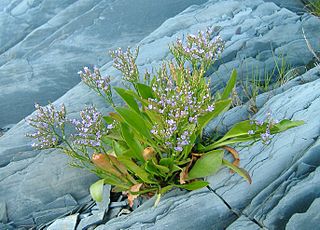
Limonium carolinianum, known variously as Carolina sealavender, canker root, ink root, marsh root, lavender thrift, American thrift, or seaside thrift, is a species of flowering plant native to the eastern shores of North America, from northern Mexico to Canada. It is a slow-growing perennial herb found in salt marshes and other maritime habitats. Its inflorescences are frequently harvested for use in cut flower arrangements.
